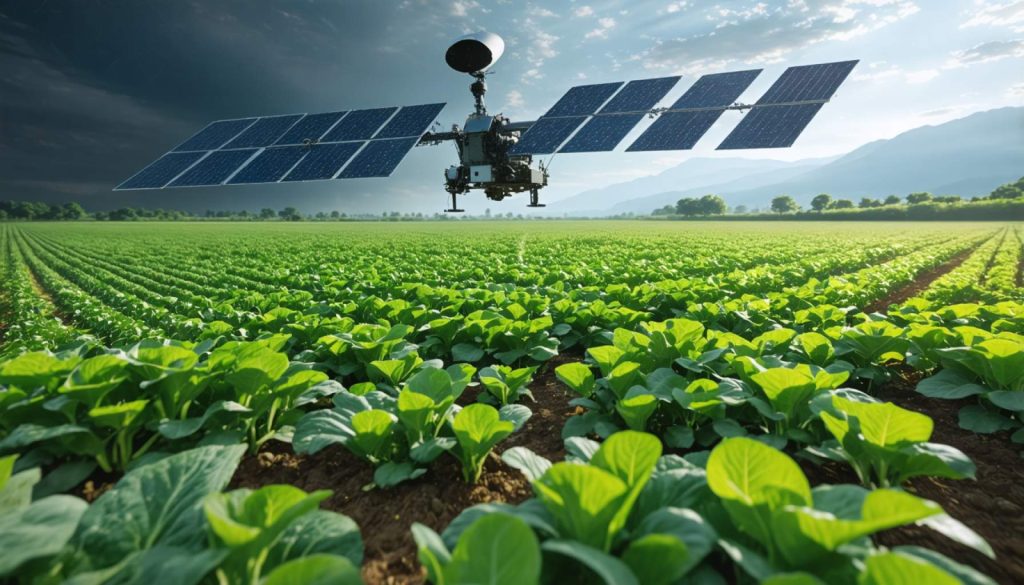
- Earth Observation technology is revolutionizing agriculture by providing comprehensive insights into crop health, water usage, and environmental impacts.
- Satellites equipped with multispectral sensors enable real-time monitoring, helping optimize irrigation, address nutrient deficiencies, and predict pest invasions.
- In Southeast Asia, satellite data aids in precise water management, conserving resources while maintaining crop yields.
- Aggregated satellite data informs larger models for policymakers to track agricultural patterns and respond to challenges like droughts.
- Public access to data from platforms like NASA’s EOSDIS and the European Space Agency’s Sentinel satellites fosters innovation in agriculture.
- Earth Observation supports sustainability by enabling informed decision-making focused on reducing chemical inputs and promoting biodiversity.
- This technological synergy highlights our ability to address environmental challenges and enhance Earth’s resources for future generations.
As we delve deeper into the 21st century, the fusion of technology and environmental stewardship stands at the forefront of innovation. Earth Observation, a tool once confined to the realm of meteorology and space exploration, now plays a crucial role in reshaping agricultural practices worldwide. These high-tech eyes in the sky offer farmers and policymakers unprecedented insights into crop health, water usage, and environmental impacts, paving the way for more sustainable farming.
Efficiency from Above
Imaging satellites orbiting our planet capture comprehensive snapshots of agricultural landscapes. Using multispectral sensors, these satellites process data invisible to the naked eye, such as infrared light, to assess plant health across vast areas. This real-time monitoring empowers farmers with critical information, enabling them to optimize irrigation schedules, address nutrient deficiencies swiftly, and even predict pest invasions before they escalate.
Consider the verdant rice paddies of Southeast Asia. Satellites can detect subtle variations in moisture content, helping farmers implement precise watering techniques that conserve water without sacrificing yield. This level of detail not only aids local farmers but informs global strategies to combat food shortages and climate change.
The Data Revolution
The treasure trove of satellite data doesn’t stop at individual farm plots. An aggregate of this information feeds into sophisticated models that reveal trends on a macro scale. Policymakers can track shifts in agricultural patterns, forecast food production levels, and respond proactively to emerging challenges such as droughts or disease outbreaks.
Remarkably, earth observation technologies have democratised access to information. Platforms like NASA’s Earth Observing System Data and Information System (EOSDIS) or the European Space Agency’s Sentinel satellites provide public access to troves of data, fostering innovation and broadening participation in agricultural research and practice.
A Green Horizon
The promise of Earth Observation extends beyond mere productivity. By equipping communities with better data, we nudge agriculture towards sustainability. Reducing chemical inputs, minimizing environmental impacts, and promoting biodiversity begin with informed decision-making, a process now exponentially enhanced by our ability to survey fields from space.
The Takeaway
Incorporating Earth Observation into agriculture marks a transformative approach to managing our planet’s resources. As satellites continue to map the complexities of our world, they emphasize the vital connection between human ingenuity and the natural environment. By embracing this powerful synergy, we can cultivate a future where technology not only sustains but enhances our Earth for generations to come.
The revolution in agriculture underscores a critical truth: the solutions to our most pressing environmental challenges often lie not beneath our feet but amongst the stars.
Unveiling the Future: How Earth Observation is Revolutionizing Agriculture
How Earth Observation is Transforming Agriculture: Beyond the Basics
Advanced Technological Features
1. Multispectral and Hyperspectral Imaging: In addition to multispectral sensors, hyperspectral sensors provide even more detailed data by capturing a broader spectrum of light. This allows for the precise identification of plant species, soil types, and even crop stress levels due to diseases or nutritional deficiencies.
2. Synthetic Aperture Radar (SAR): SAR technology enables imaging through cloud cover and during night time, ensuring continuous data collection regardless of weather conditions. It’s crucial for tracking changes in land use and crop growth patterns in tropical regions where clouds are frequent.
3. Drone Integration: While satellites give macro views, drones equipped with similar sensors provide micro-level insights. They can survey specific fields, offering high-resolution data that complements satellite information, especially in areas with frequent cloud cover.
Real-World Applications
– Precision Agriculture: By using Earth Observation data, farmers can implement precision agriculture practices. This means using the exact amount of water, fertilizers, and pesticides where and when they’re needed, thus conserving resources and minimizing environmental impact.
– Water Management: In regions where water scarcity is a significant issue, such as parts of Africa and the Middle East, Earth Observation helps in monitoring water bodies, predicting rainfall patterns, and managing irrigation schedules.
– Pest and Disease Control: Satellites can detect changes in plant coloring that may indicate pest infestation or disease, enabling early intervention before large-scale crop damage occurs.
Industry Trends & Market Forecasts
The global precision agriculture market is expected to grow significantly. According to MarketsandMarkets, it is projected to reach $12.9 billion by 2027, reflecting a growing appreciation and demand for satellite-based agricultural solutions.
Controversies & Limitations
– Data Privacy: The collection and analysis of vast amounts of data also raise questions about data privacy, especially concerning who has access to detailed agricultural data at both micro and macro levels.
– High Initial Costs: Implementing these technologies can be cost-prohibitive for small-scale farmers without governmental or institutional support.
– Technical Training: Effective use of Earth Observation data requires training and expertise, which may not be readily available in all regions, potentially creating a knowledge gap.
Security & Sustainability
– Sustainability: Earth Observation supports sustainable farming practices by minimizing chemical runoff and optimizing resource use. It also aids reforestation projects and monitors the health of natural ecosystems.
– Data Security: Systems must be safeguarded against cyber threats to protect sensitive agricultural data that could impact food security.
Practical Tips for Farmers
1. Leverage Open Platforms: Utilize free platforms like NASA’s EOSDIS or ESA’s Sentinel services to access and analyze satellite data tailored to specific agricultural needs.
2. Invest in Training: Participate in workshops or online courses that offer training on interpreting and utilizing satellite data for farming purposes.
3. Explore Partnerships: Collaborate with tech companies or agronomists who specialize in data interpretation to maximize the benefits of Earth Observation technologies.
Conclusion
The fusion of Earth Observation technology and agriculture heralds a new era of farming that is more sustainable, efficient, and responsive to global food security challenges. This powerful synergy between technological innovation and agricultural practices can lead to smarter, data-driven farming that enhances productivity while protecting our planet.
For more insights into cutting-edge technology and its impact on the environment, explore resources from leading institutions like Nasa or the European Space Agency.



